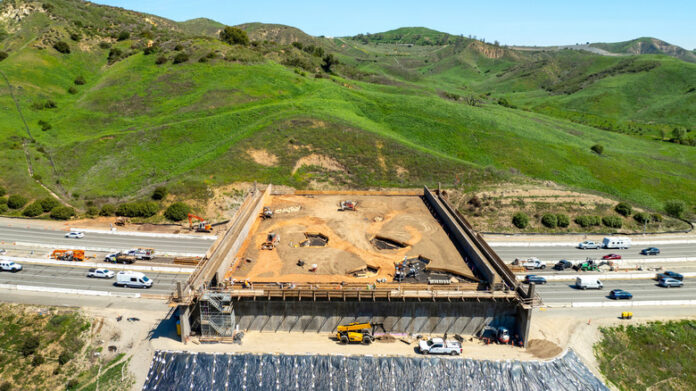The Los Angeles region is famous for its car culture; we have famously poor public transit, famously congested roads, and famously beautiful roads filled with famously beautiful people driving famously beautiful cars. Prior to its colonization, though, the region was naturally beautiful, peppered with Indigenous tribes who coexisted with the various native flora and fauna in one of the largest and most significant examples of Mediterranean-type ecosystems in the world, the Santa Monica Mountains. Once all that native beauty was sufficiently steamrolled and paved over, the region’s fragile ecosystem and endangered wildlife faced and continues to face habitat shrinkage and habitat loss, even genetic isolation. Recently, workers began laying the first of the 6,000 cubic yards of specially manufactured soil on the crossing and will soon begin seeding the soil and planting native shrubs and perennials including golden yarrow, California poppies, giant wildrye, and Santa Barbara milk vetch to recreate the native habitat and support other endangered species like the Palos Verdes blue butterfly.
Three years ago on Earth Day in 2022, the region began taking steps to restore these habitats by starting construction on the largest wildlife crossing in the world, the Wallis Annenberg Wildlife Crossing in Agoura Hills. The wildlife crossing will allow animals to cross over one of the busiest roadways in the world that sees around 300,000 travelers daily, and connect the Santa Susana Mountains, Simi Hills, and the Santa Monica Mountains. The project was delayed by about a year due to heavy rains in 2022 and 2023, and is now slated for completion toward the end of 2026.
It’s big
The wildlife crossing is located along U.S. Route 101 at the Liberty Canyon Road exit in Agoura Hills, and once completed the main structure of the Wallis Annenberg Wildlife Crossing will be about the size of a football field, or 10-to-12 acres in total. It spans across eight lanes of traffic and two breakdown lanes on the 101 Freeway, as well as a second section that will pass over the two lanes of Agoura Road. The location was determined for many reasons, including a 1987 study which identified the stretch between Agoura Hills and Hidden Hills as one of three key choke points for safe animal passageways.
Phase 2 of the project is set to begin soon, and will include a temporary closure of Agoura Road so the roadway can be covered with a tunnel and soil collected from the Malibu Lake area. The entire crossing is projected to be completed toward the end of 2026, with the goal of reconnecting the entire ecosystem for both flora and fauna to solve for genetic isolation and prevent the extinction of a mountain lion population. You can follow along with progress and see real-time webcam feeds on the 101 Wildlife Crossing website.
Why is Caltrans spending $94 million on a wildlife bridge?
The Santa Monica Mountains are one of two biodiversity hotspots in the continental U.S. that are home to over 1,000 plant species in 26 distinct natural communities. Native species include bobcats, coyotes, mountain lions, 400 species of birds, and 35 species of reptiles and amphibians. The region is also home to more than 50 endangered or threatened species of plants and animals, which is among the highest concentrations of rare species in the U.S.
The world had a love affair with the late mountain lion called P-22, who was the first mountain lion to be sighted in Griffith Park in many years, and only made it there by miraculously crossing two of the busiest freeways in the country. P-22 is the face of the #SaveLACougars campaign, which despite the various meanings of the name focuses exclusively on mountain lions, and is credited with fueling a new conservation movement. P-22 gained fans across the globe, and his story was featured in The New Yorker, Wall Street Journal, Los Angeles Times, National Geographic, BBC World News, and several more outlets before he was hit by a car and euthanized due to head trauma in late 2022.



